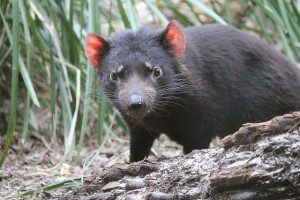Scientists suggest reintroducing the Tasmanian devil to mainland forests could restore ecological systems and save native species from extinction
Rewilding is being hailed in Europe and the U.S. as a potential solution to restore ecological systems that have become unbalanced, often from human impacts including habitat loss, animal culling or hunting, and introduced predators.
Australian researchers from the University of New South Wales and the University of Tasmania have conducted the first study to look at the feasibility of reintroducing the Tasmanian devil to mainland Australia.
Their results, published in the journal Biological Conservation, suggest that biodiversity in Australia’s native species could be improved by reintroducing the carnivorous marsupial to the mainland where it is believed to have been wiped out by the dingo around 3,000 years ago.
Dingoes have since been culled in many areas in Australia to remove the threat to livestock. This has upset the ecological balance, causing knock-on effects on native animal populations due to soaring numbers of introduced predators no longer kept under control by dingoes. Feral cats have contributed to the extinction of at least 27 mammal species, according to Greg Hunt the Australian Minister for the Environment.
The Australian government has proposed a cull of 2 million feral cats by 2020 as part of its national strategy for threatened species, but reintroducing the Tasmanian devil to restore biodiversity naturally could be a less controversial way to reduce feral cat populations.
Devil study lead author Daniel Hunter, PhD student from UNSW School of Biological, Earth and Environmental Sciences, is confident the Tasmanian devil can restore ecosystems.
“It doesn’t pose as serious a risk to livestock, and it has played a major role in stopping foxes from establishing a foothold in Tasmania.”
The team looked at previous studies to find out more about the ecological impacts of the dingo, red fox and devil. They used species distribution models to assess suitable climatic conditions on the mainland for devil existence, and fuzzy cognitive mapping to assess the impact of reintroduction on mainland ecosystems. The models reflected the devil co-habiting with red foxes and dingoes of varying populations: eradicated, reduced and abundant.
Researchers identified suitable conditions for Tasmanian devil survival in south-eastern Australia. If the Tasmanian devil is reintroduced in areas free from dingoes, such as New South Wales, it would be the top predator and would control feral cat and red fox populations.
“There is very good evidence from Tasmania that cats modify their movements and numbers are lower where there are healthy devil populations,” said UNSW co-author Associate Professor Mike Letnic.
Devil reintroduction would allow endangered native mammal and bird species to recover, without having the impact on livestock seen with dingoes. Many smaller animals such as bandicoots and potoroos that are being wiped out by feral predators on the mainland thrive in Tasmania where there are fewer feral cats and no known fox populations.
Tasmanian devils would also manage herbivorous wallabies that remove vegetation and leave smaller animals such as bandicoots and bilbies exposed to predators.
Reintroducing the Tasmanian devil to the mainland would have an added benefit of protecting the species from extinction in Tasmania. Devil numbers have fallen significantly this century due to contagious cancer identified as devil facial tumour disease.
This mysterious and as yet untreatable disease was first discovered by zoologist and Tasmanian devil expert Menna Jones, a co-author of this reintroduction study. Devils free from disease would be protected from infection on the mainland, and species survival would be more secure.
The loss of the Tasmanian devil would threaten the Tasmanian ecosystem in the same way that the gap left by the devil and dingo on the mainland has wreaked havoc on native flora and fauna.
Also published on Science Nutshell August 14, 2015
Image credit:
Tasmanian devil by Ross Hugget on Flickr CC BY-2.0
